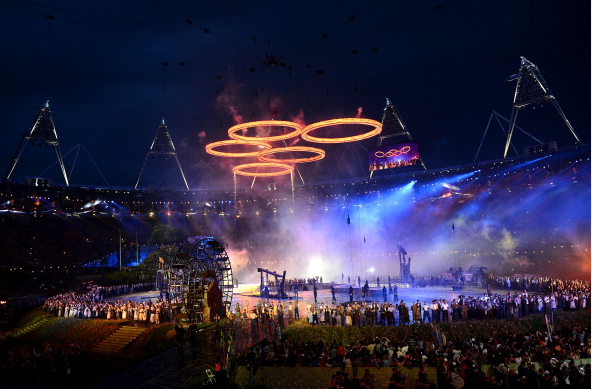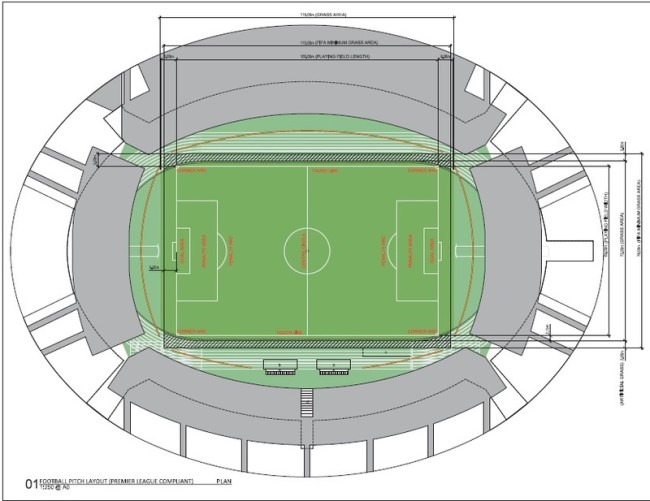You all paid for West Ham United’s Olympic stadium and cheap tickets to woo a foreign buyer

More rings than bubbles
West Ham United are moving into the 54,000-seater Olympic Stadium. If you think that’s the end of the Olympic Legacy, you’d be mistaken. The money involved is entirely in keeping with the profligate Olympic spend: the London 2012 Olympic bill came in at £9bn – far higher than the original projected cost of £2.75 billion.
The newlook Olympic stadium has cost the taxpayer a massive £702m. It was supposed to cost £280m. But somehow the fees and build soared – it cost £272m just to alter the place to become a football ground.
Why?
Dan Roan cites one expensive design flaw:
The stadium’s owners, the London Legacy Development Corporation (LLDC), admits the project is over-budget by around £35m. Putting the largest cantilevered roof in the world on to a superstructure that had not been built to bear that kind of weight was far more complex and expensive than envisaged – the contract was announced initially at £155m, before rising to £189m in October.
Compare that to the £42m required to convert the City of Manchester stadium after the 2002 Commonwealth Games.
Given that it cost a generous £798m for the 90,000-capacity Wembley (the Millennium Stadium in Cardiff cost £121m in 1999), West Ham fans cost more per head than England supporters.
And what does it cost West Ham? Well, the club will make a £15m contribution on top of the £2.5m they will pay annually for a 99-year lease. That looks cheap.
Says West Ham owner David Sullivan:
“We want to challenge the likes of Arsenal and Chelsea. We are moving into a ground with a massive capacity like the Emirates Stadium but we are selling our tickets a lot cheaper than they do. Unlike them, we don’t have the ranks of corporate fans to plough money into the club. We expect to have 40-45,000 season ticket holders in the Olympic Stadium but that won’t bring in nearly as much cash as Arsenal get.”
But…
“If the King of Saudi Arabia, I use that term loosely, or another serious investor wanted to buy West Ham, then we’d step aside for the good of the club. Like at Manchester City.”
The Hammers crave those wealthy fans. A famous venue will only help build the brand.
But first you need to get the fans inside.
Owen Gibson notes:
Never mind bubbles, West Ham executives were blowing their own trumpets on Wednesday in a PR blitz to announce cut-price season-ticket prices in their new stadium…. The move will allow them to increase hospitality revenue at the top end and fund price cuts at the bottom. Arsenal and Chelsea, the destinations of choice in London for that breed of boxholder for whom prawn sandwiches have long since become passé, will be eyeing the new competitive landscape with interest…
It is a deal that will allow West Ham to offer vastly improved hospitality – minutes from Canary Wharf and the City in a location that nestles against the leisure and shopping options of Westfield – and more expensive seats at the top end (to sit in one of the VIP 1966 seats will cost £1,100 per season).
At the same time the hope is existing season-ticket holders will upgrade to a higher band at much the same price as their existing Upton Park seat, thus creating room for new fans, or those who find tickets hard to afford, to take up the cut-price offer in the £289 band.
The option to bring children for £99 per season and offer 16-to-21-year-olds (long neglected by most clubs) discounts of around 50% will, West Ham hope, nurture a new generation of fans.
Hurrah for the Hammers, the fans’ pal. But Malcolm Clarke, chairman of the Football Supporters’ Federation, spots an issue:
“Any reduction is welcome, so two cheers for West Ham for that. But before we give them three cheers, we await to see what they do about price categories, what they do about away fans and what they do with ordinary admission.”
Glenn Moore looks at the numbers:
Gosh! How generous of Karren Brady and the Davids, Gold and Sullivan, not previously known for their altruism towards supporters. They are slashing the price of season tickets, with West Ham’s cheapest adult season costing £289 – a reduction of £331 from current prices.
But not yet. Ticket prices next season will be up to five per cent higher than current ones. The reductions will be in 2016-17. This, says Brady, the Hammers’ vice-chairman, is because that is when the new £5bn-plus TV deal kicks in, so they can cut prices.
Coincidentally it is also when West Ham move into the Olympic Stadium which, with a capacity of 54,000, has 19,000 more seats than the 35,016 at the club’s current home, Upton Park. This might be the real reason for the price cuts and explain why supporters of other teams should not expect their club to follow suit.
“I am sure other Premier League clubs will follow,” said Brady. “I go to all the Premier League meetings and ticket pricing and making it affordable is always the highest topic on the agenda.”
Good. Tickets prices are too high. But let’s not pretend West Ham are are offering cheaper ticket prices for anything other than selfish reasons.
West Ham is not a charity. Their old Boleyn ground is not to be given to the poor and needy. It’s to be redeveloped as a “village” of 838 homes, of which just 6% are earmarked as affordable.
Labour MP Stephen Timms, whose constituency includes the ground, opines:
“It does seem a particularly small proportion of the development that, in the context of Newham, seems very difficult to justify.”
And hasn’t this all been funded by public cash? Arsenal’s 60-000 all-seater Emirates Stadium cost £390m in 2006. And they had to fund it themselves. Is it fair that another Premier League club in London get their stadium on the cheap, taking advantage of the London 2012 infrastruture?
Ross Clark wonders:
What happens if West Ham decide to leave the Olympic stadium after a few seasons isn’t clear. The legacy corporation declined to reveal whether there are any break clauses in the contract which would let West Ham leave before the 99 years are up — I am told only that it believes the contract is ‘sufficiently robust to account for all scenarios’. West Ham might be in the Premiership now, but whether they would still be prepared or able to spend several million a year renting the stadium if they were relegated to a lower division — as they have been several times in the past — is another matter…
Meanwhile, Newham taxpayers are being fingered for £40 million. In return, Newham council will receive a 35 per cent share in the lease, giving it a share in income from the stadium. It will also have the right to hold ten mass community events for Newham residents every year. The council couldn’t tell me exactly what these events,would be, except that it might include a rather grand sports day for Newham schools. The council will also bag 100,000 free tickets a year to West Ham matches…
The deluge of free tickets hasn’t pleased Barry Hearn, manager of Leyton Orient, a struggling League One side which now finds itself having to compete for fans against a much richer neighbour which is showering locals with free tickets thanks to taxpayers’ largesse. West Ham’s deal is, Hearn says, ‘state sponsorship beyond my wildest dreams’.

One negative is that West Ham will share the venue with UK Athletics. Fans will walk to the ground via Medals Way and Prize Walk. As the WestHamTillIDie blog puts it:
March 2013 West Ham Joint Chairman David Gold was quoted as saying about the Olympic Stadium bidding “We will only go there if it is fit for use. I won’t go there if I have to look over a running track”
A new image has emerged showing the majority of the running track at the transformed Olympic Stadium will remain between the crowd and the football pitch even with retractable seating fully deployed.The image below was uncovered by Ali Worth after she reviewed thousands of pages publicly available planning permission documents.
Although the retractable seating will bring fans closer to the action it clearly shows much of the running track (shown as white lines) remains between the fans and the pitch on the east and west sides of the stadium. It appears many fans on both sides will in fact be looking over a running track after all although the visible parts of the running track shown as white lines on the diagram below will be hidden by a green artificial grass carpet on the 25 days it is in football mode. As we know the running track is 9 metres wide so we know the gap between the front row and the the pitch will be in excess of 9 metres at the half way line.
Running tracks around football stadium are awful. Those white lines between fans and the action are constant reminders that it’s not your home. It’s not a football ground. It’s a rented municipal sports venue.
Dan Roan spots another burning issue:
If [David] Gold and Sullivan do sell the club in the next few years for a big profit, the taxpayer will receive something back. But neither the club, the LLDC, nor the Mayor of London are prepared to tell us what proportion of any profit.
Such are the facts.
Posted: 30th, June 2015 | In: Reviews, Sports Comment | TrackBack | Permalink


